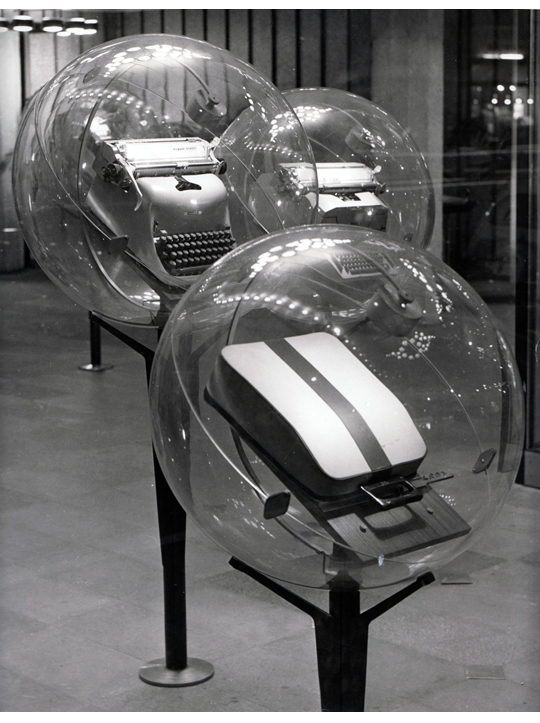 Poster for the Valentine typewriter,
Poster for the Valentine typewriter,
Designed by Walter Ballmer, 1969
Courtesy Associazione Archivio
Storico Olivetti, Ivrea, Italy
Olivetti: Beyond Form and Function
ICA Fox Reading Room
London | UK
25 May > 17 July 2016

 Olivetti Showroom, Venice, Italy
Olivetti Showroom, Venice, Italy
Designed by Carlo Scarpa, 1958
Both photos Marco Ambrosi
Courtesy of Navone Associati, Milan
My first typewriter was an Olivetti Praxis 20 Electronic Typewriter, designed by Mario Bellini in 1983. At the time I couldn’t type. I bought it because I admired its sculptural beauty. Even now, having used computer keyboards for some 30 years I remain a one finger typist. If not for Olivetti’s pioneering and beautifully designed products and their attention to the environments in which they were sold and used – hailed as the precursors to the user-friendly Apple products that began to appear in the late 1990s and and the Apple stores that followed – it’s possible that the world may not have taken up desktop and personal technology quite so swiftly or as readily as it has over the past three decades.
Polymath Ettore Sottsass, who was responsible for designing the bright red Valentine portable typewriter (above) – produced by Olivetti from 1969 to 1975 – once remarked: ‘When I began designing machines I also began to think that these objects, which sit next to each other and around people, can influence not only physical conditions but also emotions. They can touch the nerves, the blood, the muscles, the eyes and the moods of people. Since then I have never designed a product in the same way as I would design a sculpture, and I have been utterly obsessed with the idea that by designing an object or a machine I would be setting off a chain reaction of which I understood very little.’
 Poster for the Divissuma 24 calculator
Poster for the Divissuma 24 calculator
Designed by Herbert Bayer, 1950s
Courtesy Associazione Archivio
Storico Olivetti, Ivrea, Italy
 Olivetti Lettera 22, poster
Olivetti Lettera 22, poster
Designed by Giovanni Pintori, 1954
Courtesy Associazione Archivio
Storico Olivetti, Ivrea, Italy
Adriano Olivetti had established the importance of design as a pillar of the company founded by his equally forward thinking father in 1908 in Ivrea, Italy, that was growing at a phenomenal rate. As the company expanded and occupied more and more space within the city, hiring some of the country’s leading architects, the philanthropically-minded Adriano built carefully planned new neighbourhoods with abundant green space and compact apartment blocks to accommodate the expanding workforce. Arguing that because workers inside must see the mountains and valleys where they come from, and that people outside the factory should be able to observe what was going on inside, the new factory buildings were built almost entirely of glass.
In the 1950s designer Australian designer Gordon Andrews and FHK Henrion, a key figure of British post-war design, were asked to create the Olivetti London Kingsway showroom, and in 1957 Adriano commissioned architect Carlo Scarpa to design the showroom in Venice – opened in 1958, restored in 2011 – on the basis that it would be a space designed to show the products, but also to showcase Scarpa’s talent as an architect.
Sottsass was brought on board as a consultant in 1958, and in 1959 Adriano’s son, Roberto, insisted that he be allowed to design the Tekne, which would transform the typewriter into the first systematically conceived business machine. That same year Olivetti won the prestigious Compasso d’Oro with the Elea 9003, the first Italian electronic calculator (computer). Under Roberto Olivetti’s aegis, with the engineer, Mario Tchou, and using his ‘anti-machine machine’ approach, Sottsass’s relationship with the company thrived and he went on to create a series of technically innovative products that thanks to his love of pop art and interest in beat culture looked and felt very much of the moment.
 Olivetti Showroom, Barcelona, Spain,
Olivetti Showroom, Barcelona, Spain,
Designed by BBPR, 1965
Photo F Català Roca
Courtesy of Navone Associati, Milan
Numerous other well-know designers, architects and artists including Gae Aulenti, Louis Kahn, Le Corbusier, Mario Bellini, Milton Glaser, and Herbert Bayer were commissioned by Olivetti, who had also established a commercial art department within the company in 1937. From 1940 to 1967 this was led by the innovative and versatile Giovanni Pintori whose approach and aims: ‘I have always believed in the strength of simple ideas and the demand for clear, immediate language that is accessible to everyone. This doesn’t mean that the language of graphics is downgraded to the most common taste. Just the opposite: it means that the language intends to improve average tastes,’ sum up the progressive cultural ideals at the heart of the company’s ethos: a model that still resonates today.
Olivetti: Beyond Form and Function at the ICA Fox Reading Room presents Olivetti’s design work from the mid-20th century.
All images courtesy the ICA
Tell us what you think
The Blog is about art, architecture, books, design and gardens, and anything else that currently interests us that we think might interest you.
The Blog’s publishers insist that all images supplied for publication in our posts are cleared for that use before being sent to us. Whether pictures are sent to us as email attachments or made available as downloadable files, any responsibility for fees that may, under any circumstances whatsoever, fall due, must be borne by the source supplier


















